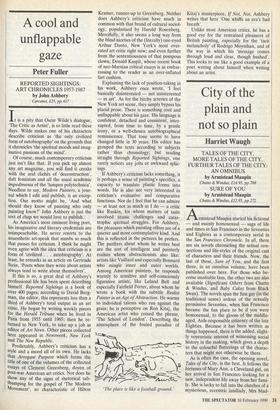A cool and unflappable gaze
Peter Fuller
REPORTED SIGHTINGS: ART CHRONICLES 19574987 by John Ashbery Carcanet, f25, pp.417 It is a pity that Oscar Wilde's dialogue, 'The Critic as Artist', is so little read these days. Wilde makes one of his characters describe criticism as 'the only civilized form of autobiography' on the grounds that it chronicles 'the spiritual moods and imag- inative passions of the mind'.
Of course, much contemporary criticism just isn't like that. If you pick up almost any art magazine, you will find it creaks with the arid cliches of 'deconstruction', daft feminism and all the usual academic impedimenta of the 'lumpen polytechnica'. Needless to say, Modern Painters, a jour- nal which I edit and publish, is an excep- tion, Our motto might be, 'And what should they know of painting who only painting know?' John Ashbery is just the sort of chap we would love to publish.
As America's most eminent living poet, his imaginative and literary credentials are unimpeachable. He never resorts to the anaesthetic art-speak that numbs so much that passes for criticism. I think he might even agree with the idea that criticism is a form of 'civilized . . . autobiography'. At least, he remarks in an article on Gertrude Stein, 'Poets when they write about artists always tend to write about themselves'.
If this is so, a great deal of Ashbery's professional life has been spent describing himself. Reported Sightings is a book of over 400 pages; according to David Berg- man, the editor, this represents less than a third of Ashbery's total output as an art critic. He began by writing weekly pieces for the Herald Tribune when he lived in Paris from 1955 until 1965; then he re- turned to New York, to take up a job as editor of Art News. Other pieces collected here appeared in Newsweek, New York and The New Republic.
Predictably, Ashbery's criticism has a style and a mood all of its own. He lacks that Arrogant Purpose which forms the title of one of the volumes of the collected essays of Clement Greenberg, doyen of Post-war American art critics. Nor does he show any of the signs of rhetorical tub- thumping for the gospel of 'The Modern Movement', so characteristic of Hilton Kramer, runner-up to Greenberg. Neither does Ashbery's criticism have much in common with that brand of cultural sociol- ogy, popularised by Harold Rosenberg. Mercifully, it also seems a long way from the blind niceties of the (literally) one-eyed Arthur Danto, New York's most over- rated art critic right now; and even further from the sententiousness of that pompous clown, Donald Kuspit, whose recent book of neo-Marxian critical essays is as embar- rassing to the reader as an over-inflated fart cushion.
Explaining the lack of position-taking in his work, Ashbery once wrote, 'I feel basically disinterested — not uninterested — in art'. As for the bitchy arteries of the New York art scene, they simply bypass his placid prose. There is something cool and unflappable about his gaze. His language is confident, detached and consistent, inter- rupted, from time to time, by a gentle irony, or a well-chosen autobiographical reminiscence. That tone seems to have changed little in 30 years. His editor has grouped the texts according to subjects rather than chronology; but reading straight through Reported Sightings, one rarely notices any jolts or awkward splic- ings.
If Ashbery's criticism lacks something, it is perhaps a sense of painting's specifics, a capacity to translate plastic forms into words. He is also not very interested in criticism's evaluative and comparative functions. Nor do I feel that he can admire — at least not as much as I do — a critic like Ruskin, for whom matters of taste involved titanic challenges and catas- trophic spiritual struggles. For Ashbery, the pleasures which painting offers are of a quieter and more contemplative kind. And this is reflected in the pictures he prefers. The pairfters about whom he writes best are the sort of intelligent and painterly realists whom abstractionists also like: artists like Vuillard and especially Bonnard who mingle inner and outer worlds. Among American painters, he responds warmly to sensitive and self-consciously figurative artists, like Leland Bell and especially Fairfield Porter, about whom he wrote a book with the subtitle Realist Painter in an Age of Abstraction. He warms to individual talents who run against the grain; he is perceptive on Ron Kitaj, the American artist who coined the phrase, 'The School of London'. Describing the atmosphere of the fouled paradise of 'The place is like a football ground.' Kitaj's masterpiece, If Not, Not, Ashbery writes that here 'One whiffs an era's bad breath'.
Unlike most American critics, he has a good eye for the restrained pleasures of British painting, especially for the 'tacit melancholy' of Rodrigo Moynihan, and of the way in which his 'message comes through loud and clear, though hushed'. This looks to me like a good example of a poet writing about himself when writing about an artist.


















































 Previous page
Previous page